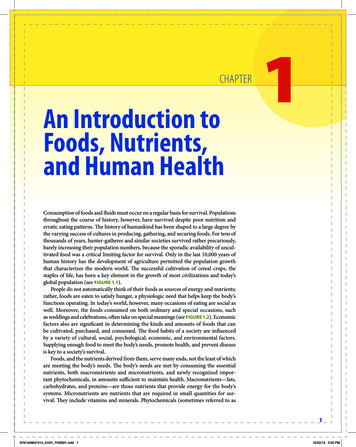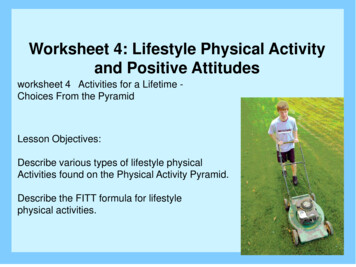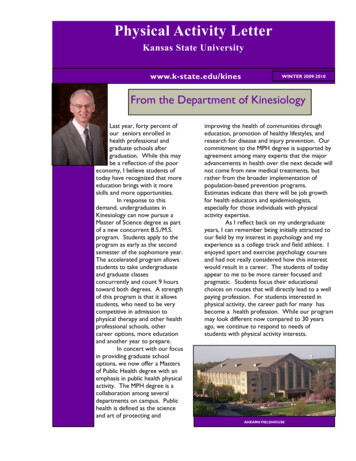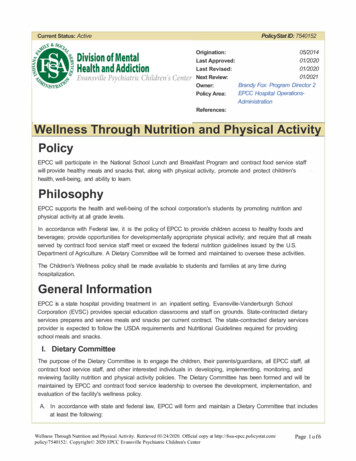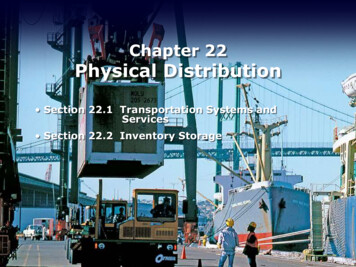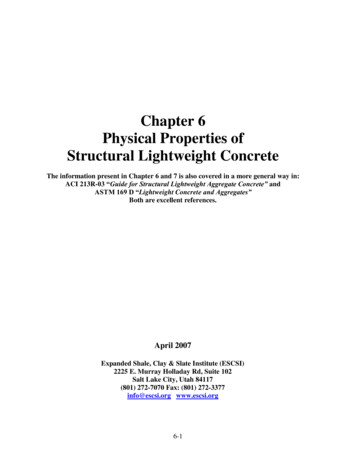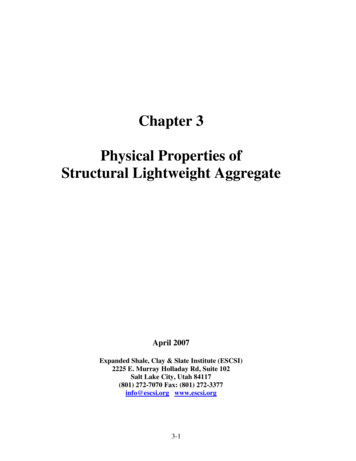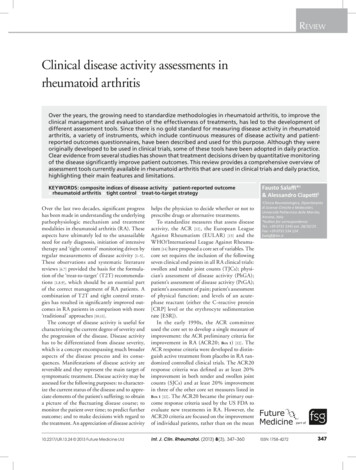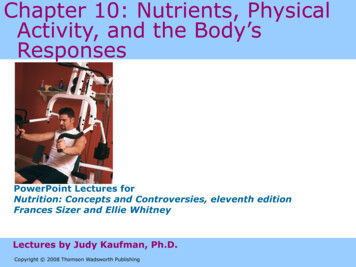
Transcription
Chapter 10: Nutrients, PhysicalActivity, and the Body’sResponsesPowerPoint Lectures forNutrition: Concepts and Controversies, eleventh editionFrances Sizer and Ellie WhitneyLectures by Judy Kaufman, Ph.D.Copyright 2008 Thomson Wadsworth Publishing
FitnessFitness depends on a certain minimumamount of physical activity or exercise.– Exercise is a vigorous, structured, and plannedtype of physical activity.– In this chapter, both words will be usedinterchangeably.
Benefits of FitnessCompared with unfit people, physically fitpeople enjoy: More restful sleep Improved nutritional health Improved body composition Improved bone density Enhanced resistance to infectious diseases Lower risk of some cancers Lower risk of cardiovascular disease
Benefits of Fitness Lower risk of type 2 diabetes Reduced risk of gallbladder disease (women) Lower incidence and severity of anxiety anddepression Stronger self-image Longer life and higher quality of life in the later years
Benefits of Fitness
Benefits of Fitness
The Essentials of FitnessTo be physically fit, you need to developenough flexibility, muscle strength,muscle endurance, andcardiorespiratory endurance to allow youto meet the demands of everyday life withsome to spare, and you need to have areasonable body composition.
How Do My Muscles Gain Strength and Size?Stretching enhances flexibilityWeight training develops muscle strengthand enduranceAerobic activity improves cardiorespiratoryendurance
How Do My Muscles Gain Strength and Size?Muscle cells respond to an overload ofphysical activity by gaining strength andsize, a response called hypertrophy.Hypertrophy: increase in muscle size inresponse to use.Muscles adapt to activities they are calledupon to perform repeatedly.– Swim to be a better swimmer– Bike to be a better biker
How Do My Muscles Gain Strength and Size?
How Do My Muscles Gain Strength and Size?Bodies are shaped by the activities theyperform
How Does Weight Training Benefit Health and Fitness?Weight training can emphasize eithermuscle strength or endurance.– Muscle strength – combine high resistance(heavy weight) with a low number of repetitions– Muscle endurance – combine less resistance(lighter weight) with more repetitions
How Does Weight Training Benefit Health and Fitness?Weight training offers health and fitnessbenefits to adults.Weight training reduces the risk ofcardiovascular disease, improves mobility,and helps maximize and maintain bonemass.
How Does Cardiorespiratory Training Benefit the Heart?Cardiorespiratory endurance trainingenhances the ability of the heart and lungsto deliver oxygen to the muscles.The heart becomes stronger, breathingbecomes more efficient, and the health ofthe entire body improves.
How Does Cardiorespiratory Training Benefit the Heart?The accepted measure of a person’scardiorespiratory fitness is maximal oxygenuptake (VO2 max).As the heart muscle becomes stronger, itscardiac output increases.The heart’s stroke volume also increases,i.e. the heart pumps more blood per beat.
The Active Body’s Use of FuelsPhysical activity is supported by differentmixtures of glucose, fatty acids, and to asmall extent amino acids, depending on theintensity and duration of its activities anddepending on the body’s prior training.
Glucose Use and StorageGlucose is supplied by dietary carbohydrateor made by the liver.It is stored in both liver and muscle tissueas glycogen.Total glycogen stores affect an athlete’sendurance.
Glucose Use and Storage
Activity Intensity, Glucose Use, and GlycogenStoresGlycogen stores are limited to less than2,000 calories of energy.Fat stores are theoretically unlimited andcan provide more than 70,000 calories andfuel hours of activity.
Anaerobic Use of GlucoseIntense activity uses glycogen quickly.Muscles must begin to rely on glucose which(unlike fat) can be partially broken down byanaerobic metabolism.Anaerobic breakdown of glucose yieldsenergy to muscle tissue when energydemands outstrip the body’s ability toprovide energy aerobically, but it does so byspending the muscle’s glycogen reserves.
Anaerobic Use of Glucose
Aerobic Use of GlucoseAerobic activity:– Moderate physical activity, such as easyjogging, uses glycogen slowly.– The person breathes easily and heart beatsfaster than at rest, but steadily.– Muscles get energy from both glucose and fattyacids (this conserves glycogen stores).
LactateLactate is produced by the anaerobicbreakdown of glucose during intenseactivity.– Lactate travels from muscles to liver where it isconverted back to glucose.– When rate of lactate production exceeds therate of clearance, intense activity can bemaintained for only one to three minutes.
Activity Duration Affects Glucose UseGlucose use during physical activitydepends on the duration of the activity andits intensity.– First 10 minutes – glycogen used by muscles– First 20 minutes of moderate activity – about1/5 of available glycogen used up– A person who exercises for longer than 20minutes begins to use less glucose and more fatfor fuel
Activity Duration Affects Glucose Use– Glycogen depletion occurs after 2 hours ofvigorous exercise.– After that, vigorous activity can continue for ashort time as the liver converts lactate andsome amino acids into glucose.– Finally, hypoglycemia occurs which brings thenervous system almost to a halt, makingintensive activity impossible.– This is what marathon runners call “hitting thewall.”
Maintaining Blood Glucose for Activity4 strategies can help to maintain bloodglucose to support sports performance1. Eat a high-carbohydrate diet ( 70% of energy)2. Take glucose (usually in sports drinks) duringactivity3. Eat carbohydrate-rich foods after performance4. Train the muscles to maximize glycogen stores
Maintaining Blood Glucose for ActivityThose who compete in endurance activitiesrequire fluid and carbohydrate fuel
Glucose during ActivityGlucose ingested before and duringendurance or intense intermittent activities(lasting more than 45 minutes) makes itsway to the working muscles and adds to theglycogen stores.For activities less than 45 minutes, glucoseprobably won’t help (or harm) performance.
Carbohydrate LoadingCarbohydrate loading is a technique tomaximize muscle glycogen before acompetition– Can nearly double the muscle glycogenconcentrations– Can benefit an athlete who keeps going 90minutes or longer
Carbohydrate Loading
Glucose after ActivityEating high-carbohydrate foods within 2hours after physical activity also enlargesglycogen stores.– Crackers– Orange juice– Toast– Cereal– Sports drinks
Degree of Training Affects Glycogen UseHighly trained muscles use less glucose andmore fat than do untrained muscles toperform the same work, so their glycogenlasts longer.
To Burn More Fat during Activity, ShouldAthletes Eat More Fat?Athletes who eat high-fat diets may burnmore fat during endurance activity, but therisks to health outweigh any possibleperformance benefits.The intensity and duration of activity, aswell as the degree of training, affect fat use.
To Burn More Fat during Activity, ShouldAthletes Eat More Fat?“Spot Reducing” does not work; muscles donot own the fat that surrounds them.Fat cells release fatty acids into the bloodfor all the muscles to share.– A tennis player has same fat fold measurementin both arms but one may have betterdeveloped muscles than the other.
Using Protein and Amino Acids to Build Musclesand Fuel ActivityThe body handles protein differently duringactivity than during rest.
Protein for Building Muscle TissueIn the hours after physical activity, musclesspeed up the rate of protein synthesis.Physical activity, with a slight overload, callsinto action protein-dismantling and proteinsynthesis in individual muscle cells.
Protein for Building Muscle TissuePhysical activity itself triggers the buildingof muscle proteins
Protein for FuelProteins contributes about 10 percent of thetotal fuel used, both during activity andrest.Athletes use a little more protein as fuelthan non athletes.
Diet Affects Protein Use during ActivityA carbohydrate-rich diet spares protein frombeing used as a fuel.Some amino acids will be converted toglucose if your diet is low in carbohydrates.
Intensity and Duration Affect Protein UseEndurance athletes who train for over anhour a day, engaging in aerobic activity ofmoderate intensity and long duration, maydeplete their glycogen stores by the end oftheir training and become more dependenton body protein for energy.Anaerobic strength training does not usemore protein for energy but does needmore protein to build muscle.
Intensity and Duration Affect Protein UseThe protein needs of both endurance andstrength athletes are higher than those ofsedentary people, but not as high as theprotein intakes many athletes consume.
Degree of Training Affects Protein UseThe extent of training affects the use ofprotein.In strength athletes the higher the degreeof training, the less protein a person usesduring activity at a given intensity.
How Much Protein Should an Athlete Consume?
Vitamins and Minerals – Keys toPerformanceMany vitamins and minerals assist inreleasing energy from fuels and transportingoxygen.
Do Nutrient Supplements Benefit AthleticPerformance?Nutrient supplements do not enhance theperformance of well-nourished athletes oractive people.Active people eat more food; if they choosecorrectly, they will get more nutrients.
Nutrients of Special ConcernActive people who eat well-balanced mealsdo not need vitamin or mineralsupplements.– Vitamin E and iron will be discussed becausemany athletes take supplements and iron isspecial to female athletes.
Vitamin EDuring prolonged, high-intensity activity,the muscle’s consumption of oxygenincreases tenfold or more, enhancing theproduction of free radicals.Vitamin E is an antioxidant and someathletes take megadoses of vitamin E toprevent oxidative damage to muscles.There is little evidence that vitamin Esupplements can improve performance.
Iron and PerformancePhysically active young women areespecially prone to iron deficiency becauseof:– Habitually low intakes of iron-rich foods– High iron losses through menstruation– High demands of muscles for iron
Iron and PerformanceFemale athletes may be at special risk ofiron deficiency
Iron and PerformanceEarly in training, athletes may develop lowblood hemoglobin.– Sports anemia – an adaptive, temporaryresponse to endurance training.
Iron and PerformanceFoods like these are packed with thenutrients that active people need.
Fluids and Temperature Regulation inPhysical ActivityPhysically active people lose fluids and mustreplace them to avoid dehydration.A water loss of 7% is likely to lead tocollapse.
Temperature RegulationHeat stroke – a dangerous accumulation ofbody heat with a loss of fluid.– Symptoms ClumsinessBody temp above 104oF ConfusionNausea DizzinessHeadache Stumbling Sudden cessation of sweating (hot, dry skin)
Temperature RegulationHypothermia can occur in cold weather.– Loss of body heat
Fluid Needs during Physical ActivityEndurance athletes can lose 1.5 quarts ormore of fluid during each hour of activity.During activity thirst becomes detectableonly after fluid stores are depleted.
Fluid Needs during Physical Activity
Fluid Needs during Physical ActivityActive people need extra fluid, even in coldweather
WaterWater is the best drink for most physicallyactive people, but endurance athletes needdrinks that supply glucose as well as fluids.
Electrolyte Losses and ReplacementThe body adapts to compensate for sweatlosses of electrolytes.Athletes are advised to use foods, notsupplements, to make up for these losses.
Consumer Corner:to Offer?What Do Sports Drinks Have
Sodium DepletionHyponatremia – a dangerous condition ofsodium depletionCan occur when endurance athletes drinksuch large amounts of water over thecourse of a long event that they overhydrate, diluting the body’s fluids to such anextent that the sodium concentrationbecomes too low
Sodium DepletionTo prevent hyponatremia, sports drinks aremore helpful than water.In the days before the event, athletesshould not restrict salt in their diets.
Other BeveragesCaffeine-containing drinks within limits maynot impair performance, but water and fruitjuice are preferred.Alcohol can impair performance in manyways and is not recommended.
Food Feature:Choosing a Performance DietMany different diets can support an athlete’sperformance.
Food Feature:Choosing a Performance Diet
Food Feature:Choosing a Performance Diet
Food Feature:Choosing a Performance Diet
Food Feature:Choosing a Performance Diet
Controversy:Ergogenic Aids:Breakthroughs, Gimmicks, or Dangers?The large majority of legitimate researchhas not supported the claims made forergogenic aids.Training serves an athlete better than any pills or powders.
CaffeineCaffeine seems to provide a physical boostduring endurance sports.Little or no effect for athletes in shortduration sports.
CarnitineCarnitine is a nonessential nutrient oftenmarketed as a “fat burner.”Carnitine supplementation neither raisesmuscle carnitine levels nor enhancesexercise performance.
Chromium PicolinateChromium picolinate promises to burn fatfrom the body.Chromium is an essential trace mineralinvolved in lipid and carbohydratemetabolism.Majority of studies showed no effect onbody fatness, lean body mass, strength orfatigue.
CreatinePower athletes often use creatinesupplements in the belief they enhancestores of the high-energy compoundcreatine phosphate in muscles.Creatine may enhance performance of highintensity strength activities such as weightlifting or competitive swimming.But creatine does not benefit enduranceactivity.No long-term studies for safety.
Conjugated Linoleic AcidConjugated linoleic acid (CLA) arisesfrom the essential fatty acid linoleic acid.In human beings, may provide a smallincrease in lean body mass and reductionsin body fat, but no improvements instrength.Too early to know if CLA is worth the costand is safe.
Amino Acid SupplementsTo build protein, all the essential aminoacids must be in the blood prior to physicalwork for maximum gains.The best source for these amino acids isfood, not supplements. All amino acids are in a well-balanced diet. Supplements may not provide the ideal balance. Only a few grams of amino acids are needed andheavy doses from supplements are not needed. Supplements can lead to digestive disturbances.
Complete Meal ReplacersSpecialty drinks and candy bars, packedwith vitamins, minerals, and other healthysounding goodies, appeal to athletes.They may taste good but fall short ofproviding “complete” nutrition and often arehigh in fat and sugar.These meal replacers may be useful as apregame meal or a snack but are inferior tonutritious foods for meeting the high needsof athletes.
Hormone PreparationsAnabolic steroid hormones producemuscle size and strength far beyond thatattainable by training alone, but are verydangerous.
Hormone Preparations
Steroid Alternative SupplementsSteroid alternatives, such as the officiallybanned “andro” (androstenedione) orDHEA, produce unpredictable results.Illegal to sell and banned by many sportsorganizations including the InternationalOlympic Committee.These products may be as risky as steroiddrugs and provide no competitive edge insports.
Drugs Posing as SupplementsA potent thyroid hormone known as TRIAChas been recalled by the FDA.– TRIAC has caused heart attacks and strokes
ConclusionThe scientific response to ergogenic claimsis “let the buyer beware.”Touted heavily in bodybuilding and healthmagazines even though none have beenscientifically shown to be effective.
The Active Body’s Use of Fuels Physical activity is supported by different mixtures of glucose, fatty acids, and to a small extent amino acids, depending on the intensity and duration of its activities and

